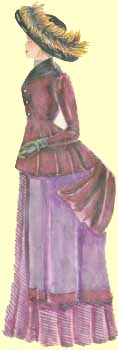
Political Awareness | In Parliament | The Workplace | Why South Australia?
The Aboriginal Voice | Cultural Diversity

 Federation
chronology
Federation
chronology
This chronology is adapted and reprinted from the The Macquarie encyclopedia of Australian events devised by Bryce Fraser, and edited by Bryce Fraser and Ann Atkinson (Sydney, Macquarie Library, 1997) with kind permission of the publishers The Macquarie Library Pty Ltd. Macquarie publishes many excellent reference tools including its famous range of Australian dictionaries and thesauruses, and books of slang, quotations, and Aboriginal words, among others.
"The complications of administering the six Australian colonies were apparent by the 1840s. After each attained self-government, the problems compounded. Aspects of inter-colonial trade, with customs posts on the borders, were at times farcical; the colonies were even setting up their own defence forces. Far-sighted men fought for years to bring the individualistic colonists together to form one nation.
1846
September. New South Wales Governor Fitzroy identified the need for a central authority to approve all measures affecting Britain or the other colonies, because of the delays involved in referring matters back to Westminster1847
British Colonial Secretary Earl Grey suggested the setting up of some kind of central body to cooperate on matters such as communications, posts and customs1849
As a result of criticism, especially in New South Wales, Grey withdrew his federal scheme and a proposed constitution1857
A report by a Victorian Parliamentary committee under Gavan Duffy summarised the first phase of the debate about federation1871
British troops were withdrawn from Australia and small local contingents took their place1880
New South Wales Premier Henry Parkes put forward the idea of a Federal Council1883
Meeting of Premiers in Sydney calls for creation of a Federal Council of Australia1889
24 October. At Tenterfield in northern New South Wales, Premier Parkes called for replacement of Federal Council with a strong central parliament, Prime Minister and Cabinet1890
February. Premiers meeting and two New Zealand representatives discussed federation proposals and agreed to call a convention the following year1891
March. The first federal Convention of 46 delegates from all colonial parliaments and New Zealand met in Sydney. Samuel Griffith Queensland Premier did most to shape the draft Constitution which resulted.1895
Premiers agreed to another convention. Enabling Acts were to go through colonial legislatures authorising popular election of delegates1896
November. An unofficial "People's Federal Convention" at Bathurst discussed problems in devising an equitable method for distributing "surplus" Commonwealth revenue once the states gave up their collection of customs duties1897
March-April. The second Federal Convention met in Adelaide to begin drawing up a constitution with delegates from all colonies except Queensland1897
May-September. Constitution Bill debated in the various colonial parliaments1897
2-24 September. Federal Convention met again in Sydney1898
20 January-17 March. Third session of Convention took place in Melbourne and completed draft Constitution1898
3-4 June. Referendum to approve the constitution was passed with substantial majorities in South Australia, Victoria and Tasmania. New South Wales' small majority did not reach the statutory minimum1899
January-February NSW Premier convened a conference of Premiers, which passed amendments to appease New South Wales and Queensland, one concerned the site of the national capitalApril-July. A second referendum on the amended Constitution was passed, with bigger majorities in South Australia, New South Wales, Victoria and Tasmania
2 September. Queensland approved the Constitution Bill. Only Western Australia held out, mainly worried by the financial clauses
1900
May-June. The Commonwealth Constitution Bill passed through the British ParliamentJune. At the last minute, Western Australia joined the federation after a successful referendum, held largely in response to pressure from goldfields settlers
9 July. Queen Victoria gave assent to an Act to constitute the Commonwealth of Australia"

| Copyright
©
2001 State Library of South Australia Disclaimer This page last updated on Thursday 24 October, 2013 13:38 Comments and enquiries to webmaster@slsa.sa.gov.au |
State Library of South Australia
North Terrace Adelaide 5000 Phone : +61 8 8207 7250 Fax : +61 8 8207 7307 Freecall : 1800 182 013 |